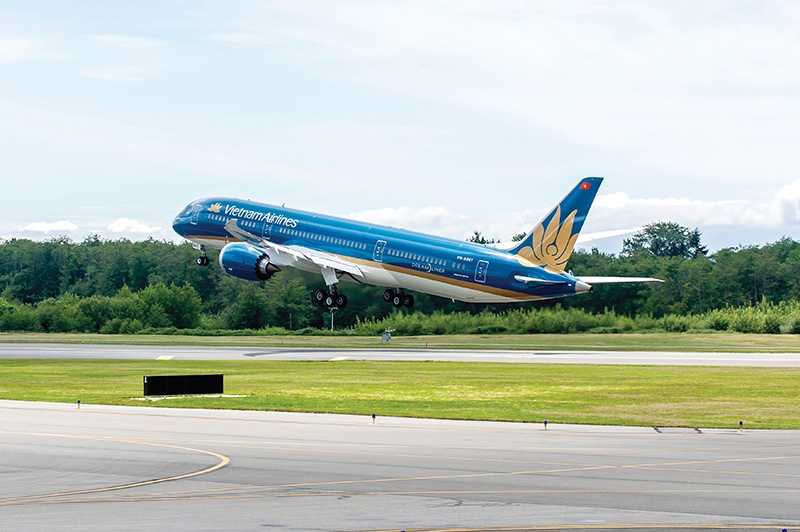Issuance plan propels flag carrier’s fortunes
 |
| Vietnam Airlines was projected to have made losses of nearly $625 million last year |
National flag carrier Vietnam Airlines is proceeding with its plan to issue VND8 trillion ($347.8 million) worth of shares for its existing stakeholders in a move to boost its recovery from the pandemic and return to profitability by 2023.
Vietnam Airlines chairman Dang Ngoc Hoa said the issuance would be completed by June and all capital raised will pay off outstanding debts. “We have suffered from the worst crisis ever due to restrictions of governments around the world to curb the spread of the virus,” Hoa said.
State Capital Investment Corporation (SCIC) has been authorised to buy the shares as stated in Resolution No.194/NQ-CP on supporting policies for Vietnam Airlines to ease difficulties caused by the pandemic.
On January 13 senior leaders of Vietnam Airlines met with SCIC counterparts at the latter’s headquarters in Hanoi to discuss implementation of Resolution 194.
The parties were set to sign a commitment of confidentiality for SCIC and consulting units to analyse and evaluate the issuance plan as well as a restructuring plan of Vietnam Airlines.
Although the new share issuance would, in normal times, seem a good opportunity for existing shareholders to increase their position, struggling Japanese group ANA Holdings will likely have to wait in order to realise its dream to expand its status in Vietnam’s aviation industry.
The only overseas investor with a stake in the Vietnam Airlines is ANA, which holds 8.77 per cent. ANA Holdings has suffered much from the pandemic. In October, the group incurred a record regional net loss of ¥530 billion ($5.04 billion) for the business year through March.
The company has decided on a plan to reduce the number of employees by some 3,500 people by fiscal year 2022 in an effort to survive the coronavirus crisis. It is also set to receive about ¥400 billion ($3.8 billion) in subordinated loans from five lenders.
ANA began its strategic partnership with Vietnam Airlines in 2016 as part of efforts to tap into the potential of the Asia-Pacific market.
Vietnam’s flag carrier received a lifebuoy in November with Resolution 194, which enabled the airline to receive two preferential loans of VND4 trillion ($174 million) at a refinancing rate of 0 per cent from the end of last year. The refinancing period is maxed out at 365 days, but can be automatically extended twice to a maximum of three years.
After issuance of the shares, Vietnam Airlines will look to pay off overdue debts and offset capital shortage in production and business. However, the cash cannot be used for investment activities or any activity not directly serving production and business.
Nguyen Chi Thanh, general director of SCIC said, “Vietnam Airlines immediately began to work out a plan to issue shares to increase its charter capital, reporting to the State Securities Commission for comments. It is SCIC’s role to determine a fair issue price to buy. We are working with Vietnam Airlines to determine the issue price of shares.”
In order to determine the price of the shares, the valuation of Vietnam Airlines must be determined. To do so, a 5-year business plan is required – something that will be a complex task amidst current flight chaos and no way of knowing how many international passengers there will be.
“This deal will not be easy. Decisions must comply with the law and must meet the ultimate goal of preserving and developing capital. Vietnam Airlines must find a way to develop safely,” Thanh added.
The national flag carrier, 86 per cent owned by the government, was expected to make losses of over VND14.4 trillion ($624.6 million) in 2020, about VND2.4 trillion ($104 million) less than previously expected.
According to Pham Van Hao, deputy head of the Civil Aviation Authority of Vietnam, the country’s aviation industry could take three years to return to 2019 levels.
What the stars mean:
★ Poor ★ ★ Promising ★★★ Good ★★★★ Very good ★★★★★ Exceptional
Related Contents
Latest News
More News
- Vietnam’s green transition demands collective financial action (December 15, 2025 | 12:00)
- VIR workshop highlights capital and policy for sustainable development (December 15, 2025 | 11:00)
- National Assembly approves pilot mechanisms to accelerate major projects in Hanoi (December 12, 2025 | 11:29)
- Vietnam eases policy approval requirements, simplifies foreign and outbound investments (December 11, 2025 | 17:53)
- Unpacking new momentum in Vietnam’s M&A market (December 10, 2025 | 09:59)
- Forum honours outstanding M&A deals, strategies, and advisory firms (December 09, 2025 | 18:22)
- Vietnam enters defining phase of M&A growth (December 09, 2025 | 17:00)
- Vietnam’s M&A market opens new opportunities amid strong economic momentum (December 09, 2025 | 15:00)
- Vietnam M&A Forum 2025: new position, new momentum (December 09, 2025 | 14:30)
- FDI in Vietnam jumps on additional capital and share purchases (December 09, 2025 | 13:56)

 Tag:
Tag:






















 Mobile Version
Mobile Version